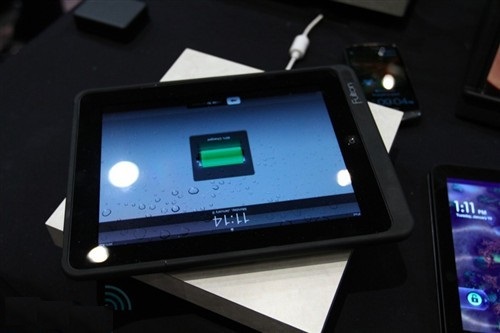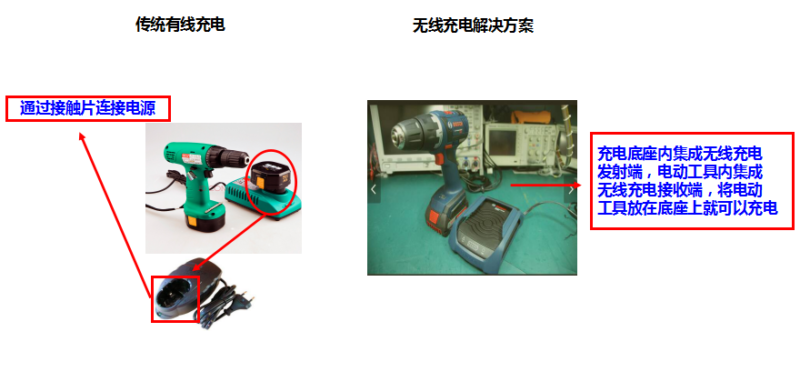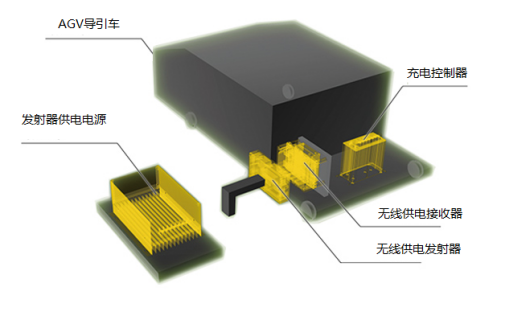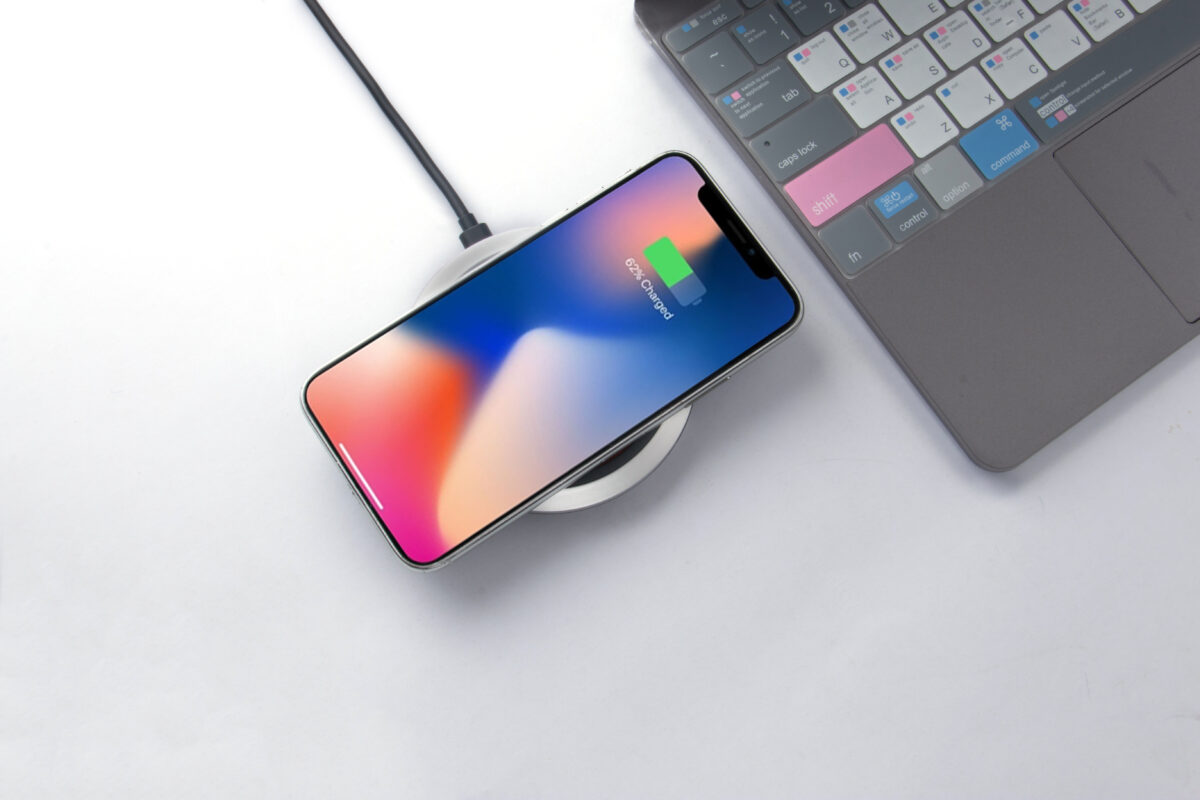Industrial Panel PC – Wireless Charging Solution
At present, the pain point analysis of industrial tablet PC charging:
Status: Existing industrial-grade tablet PCs all have a power charging interface, through which an external power supply is connected to charge the internal battery.
Pain point: Due to the existence of a power charging interface, in the industrial field, the working environment of the product is very poor, which will cause foreign objects such as dust to enter the product through the charging interface, resulting in product damage or shortened life.
The solution – using wireless charging technology:
As shown in the figure below, the white one is a wireless charging transmitter. The wireless charging receiver is integrated in the tablet computer. When the tablet computer is placed on the transmitter, it will automatically charge.

Advantages of wireless charging technology applied to tablet computers:
1. Waterproof and dustproof, no need to worry about the harsh environment of the factory
2. Just put and charge, convenient and fast
3. There is no need to plug and unplug the charging cable when charging, and the service life is longer
Mobile Robots – Wireless Charging Solutions
Analysis of current mobile robot charging pain points:
Status quo: Most of the existing mobile robots use the contact charging method, which is usually connected with the charging equipment by means of laser rangefinders, vision sensors or infrared detectors, but there are the following pain points;
Pain point 1: The robot needs navigation behavior to move from the current position to the charging base, which is limited by the positioning error, the navigation accuracy is low, and it is not easy to align the charging contacts
Pain point 2: The docking between the robot and the contact of the charging base requires high accuracy, which increases the complexity of the design and the difficulty of control. At the same time, the docking operation is very complicated and takes a long time.
Pain point 3: Frequent docking can easily affect the reliability of the system. For example, multiple plugging and unplugging operations will cause mechanical wear, resulting in loose contacts and ineffective power transmission; if the connecting parts are dirty, it will lead to poor contact or electrical Connection failure; if it is in a humid or conductive medium environment, it is also easy to cause a short circuit
The solution – using wireless charging technology:
As shown in the figure below, the wireless charging transmitter is integrated in the charging base, and the wireless charging receiver is integrated in the robot. When the robot is close to the base, the charging is automatically completed.

Advantages of wireless charging technology applied to mobile robots:
1. No charging metal contacts, no charging sparks, safer charging
2. No need for precise alignment when charging
3. The charging stand and the product itself are waterproof and dustproof, so there is no need to worry about the dust entering the charging port and affecting the life of the product
4. Wireless charging is space charging, no need to worry about wear and tear of metal terminals, long service life
Garden Tools – Wireless Charging Solutions
At present, the pain point analysis of garden tool charging:
Status quo: Garden tools work outdoors, and their charging stations are generally placed outdoors. When charging products, contact charging methods are used, and there are the following pain points;
Pain point 1: Since the charging station is generally placed outdoors, if there are foreign objects (such as leaves, soil or sand, etc.) on the charging metal terminals, when the machine returns to the charging station and wants to charge, it will be unable to charge due to the presence of foreign objects.
Pain point 2: The charging station is placed outdoors, and the charging metal terminals are easily stained with water in rainy days or winter. The terminals are prone to rust over time, and there is a risk of short circuit
Pain point 3: Frequent docking between the machine and the charging station will easily affect the reliability of the system. For example, multiple plugging and docking operations will cause mechanical wear of the terminals, resulting in loose contacts and ineffective power transmission;
The solution – using wireless charging technology:
As shown in the figure below, set up a wireless charging base on the outdoor lawn. When the product needs to be charged, it will automatically return to the charging base for automatic charging.

The advantages of wireless charging technology in garden tools:
1. No charging metal contacts, safer charging
2. No need for precise alignment when charging
3. The charging stand and the product itself are waterproof and dustproof, so there is no need to worry about the dust entering the charging port and affecting the life of the product
4. Wireless charging is space charging, no need to worry about wear and tear of metal terminals, long service life
Power Tools – Wireless Charging Solutions
Analysis of current electric tool charging pain points:
Status quo: At present, most power tools need to pull out the internal battery pack when charging, and then insert the battery pack into the charger, so that the contact piece of the charger is connected to the contact piece of the battery for charging, but there are the following pain points:
Pain point 1: Charging in this way will cause the contact sheet to oxidize or deform after a long time, resulting in poor contact between the two, and it can no longer be charged normally.
Pain point 2: Users cannot continue to work unless they replace the tool with another battery during the charging process. Users need to carry multiple batteries in their daily work, and even need to find a way to remember which batteries have been charged and which need to be charged. . Various inconveniences result in wasted time and seriously affect work efficiency.
The solution – using wireless charging technology:
As shown in the figure below, the wireless charging transmitter is integrated in the charging base, and the wireless charging receiver is integrated in the power tool. The power tool can be charged by placing it on the base.

The advantages of wireless charging technology in power tools:
1. After the wireless charging is realized, the power tool can be charged as soon as it is placed, which is convenient and fast
2. Waterproof and dustproof, no need to worry about the dust entering the charging port and affecting the product life
3. Non-contact charging, no need to worry about sparks and metal contact wear, longer service life
Drones – Wireless Charging Solutions
Analysis of current drone charging pain points:
Status quo: Unmanned aerial vehicles, especially multi-rotor unmanned aerial vehicles, usually use rechargeable lithium batteries as driving energy to work. Although the charging technology of rechargeable lithium batteries currently used has been greatly improved, in There are still the following pain points in actual use:
Pain point 1: Unmanned aerial vehicles need to be charged frequently in actual use, which will frequently plug and unplug the charging connector, which will easily cause the terminals of the connector to wear and oxidize, resulting in poor charging.
Pain point 2: At present, the drone is not really “unmanned”, and it needs to be charged frequently in actual use. When charging, an independent charging device is required, and the charging connector and the charger must be manually connected. Someone needs to be on duty to charge, which wastes manpower and material resources.
Solution – using wireless charging technology:
As shown in the figure below: a wireless charging platform (built-in wireless charging transmitter) is placed on the ground, and the drone has a built-in wireless charging receiver. When the drone needs to be charged, it will automatically return to the wireless charging platform on the ground for automation Charging, to achieve real unmanned automatic charging.

Advantages of wireless charging technology applied to drones:
1. Unattended automatic charging can be realized, so as to be truly “unmanned”, the charging platform is waterproof and dustproof, and has high reliability.
2. It can improve the endurance of the drone without changing the battery, which can reduce the manpower configuration and reduce the trouble of changing the battery at a fixed point.
3. As a ground relay gas station, stop anywhere and feel free
AGV truck – wireless charging solution
Analysis of current AGV charging pain points:
Status: AGV’s current charging methods are divided into two types, offline charging and online charging.
The pain points of offline charging are as follows:
There are two methods for offline charging,
The first method is to replace the AGV battery. The pain point is: it takes a long time to replace the battery, and it is troublesome to disassemble. It is necessary to reserve multiple batteries for charging turnover;
The second method is to use a plug at a fixed charging position, and reserve multiple AGVs for the waiting time for charging.
The pain points of online charging are as follows:
Online charging generally adopts the method of brush plate brush block for contact charging, and the charging contacts are worn out and need to be replaced regularly. There is a safety hazard due to the large charging current and possible sparks during charging. In addition, because the charging contacts are exposed parts, they cannot work normally in low temperature condensation, humidity, flammable and explosive environments.
The solution – using wireless charging technology:
As shown in the figure below, a wireless charging and charging platform (including a transmitter power supply and a wireless power supply transmitter) is set in the factory, and a wireless power supply receiver and a charging controller are built into the AGV trolley.

When the wireless charging receiving device in the car is aligned with the wireless charging transmitting device of the charging platform, the wireless charging of the AGV car can be realized;
Many wireless charging platforms are set up in the factory, and the AGV uses the fragmented time to charge randomly, which can make the AGV have power for 24 hours without having to replace the battery, and can also reduce the capacity and cost of the battery.
The advantages of wireless charging technology in AGV car:
1. There is no danger of sparks when charging
Unlike contact charging (metal contact contact charging) used in general charging systems, because we use “inductive charging” (wireless connection), there is no risk of electric shock or sparks; it can be used in low temperature and humidity. , flammable and explosive environments.
2. No need to set special charging area
The wireless charging system does not generate sparks in the charging area, so it is not necessary to set up any special charging area; increasing the space utilization rate of customers.
3. Reduce the labor cost of charging
You can set the charging area anywhere, and the AGV can automatically charge at the parking spot or within the operating area. It is no longer necessary to move the AGV specifically to the charging point and replace the AGV battery. Therefore, the use of human resources and the loss of machine downtime can be reduced, and the production efficiency can be improved.
4. AGV can run automatically for 24 hours!
Several charging points can be set up in the factory, and the AGV can make full use of the gap time for charging at any charging point, so that the AGV’s battery is always charged for 24 hours; so that the AGV can ensure that power is available at any time, thereby improving production efficiency.
5. Reduce battery backup!
Because the AGV will automatically charge when running through wireless charging. This allows for fewer battery backups and lower operating costs.
6. Long battery life!
The traditional charging, due to the particularity of the battery, repeats the rapid charging at a lower depth of discharge, which makes the aging of the plate faster and shortens the service life of the battery. Whereas wireless charging can automatically charge at every stopping point with relatively little depth of discharge (battery drain) and extended battery life.
7. High durability!
With inductive charging and protection of the charging point through coupling, there is no metal corrosion for better durability and longer life than typical contact charging (metal-to-metal contact).

